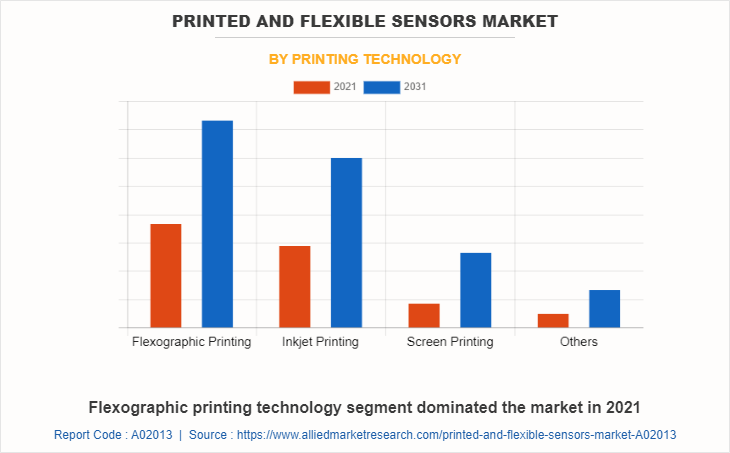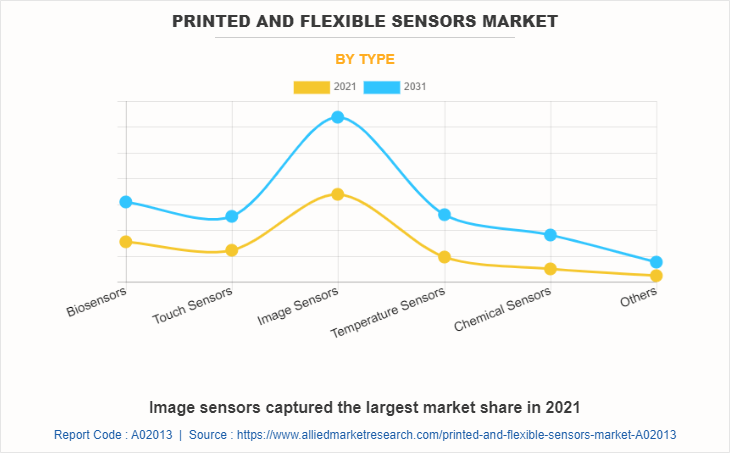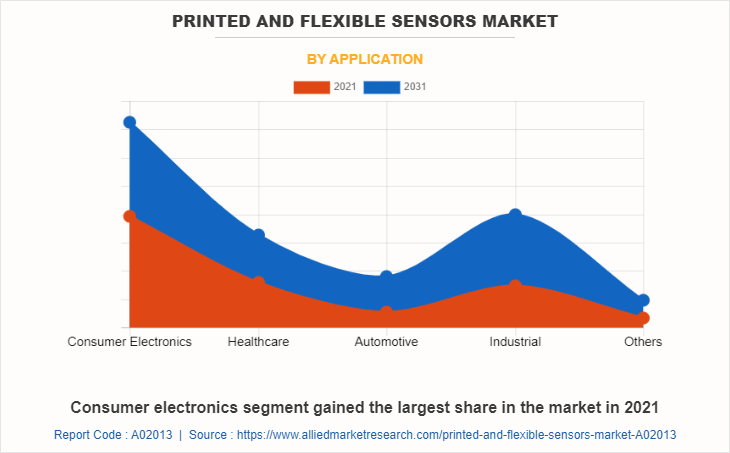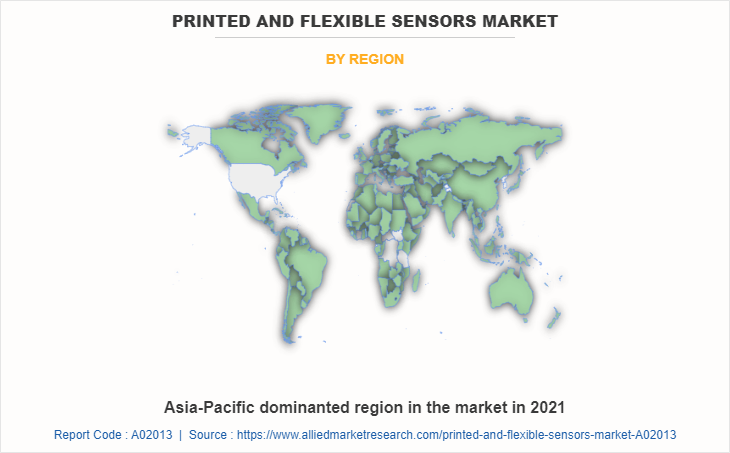Printed & Flexible Sensors Market Research, 2031
The Global Printed & Flexible Sensors Market was valued at $3.9 billion in 2021 and is projected to reach $8.6 billion by 2031, growing at a CAGR of 8.3% from 2022 to 2031.
The printed & flexible sensors market outlook is fairly competitive, owing to the strong presence of existing vendors. Market vendors are expected to gain a competitive advantage over their competitors because they can cater to market demands with a wide range of products. The competitive environment in this market is expected to increase as technological innovations, product extensions, and different strategies are adopted by key vendors.

Segment Overview
The printed & flexible sensors market is segmented into Printing Technology, Type, and Application.
Based on printing technology, the printed and flexible sensors industry is segmented into flexographic printing, inkjet printing, screen printing, and others. The flexographic printing technology segment dominated the printed and flexible sensors market in terms of revenue in 2021. However, the screen printing technology segment is expected to expand at a higher growth rate during the forecast period. Flexographic printing technology is widely used in manufacturing printed and flexible sensors for the advantages which it provides. For example, it is a low-cost printing technology and allows for the manufacturing of better quality and integrity of flexible sensors.

Based on type, the printed and flexible sensors market size is segmented into biosensors, touch sensors, image sensors, temperature sensors, chemical sensors, and others. The image sensors segment dominated the printed and flexible sensors market share in 2021, whereas the chemical sensors segment is likely to expand at a faster rate during the forecast period. Optical-imaging-based devices such as X-rays are widely used to diagnose diseases in hospitals, specifically because light can measure inside information from outside the body. Further, flexible image sensors can be attached directly to a curved surface like skin to continuously measure biometric information with a high level of accuracy. As such, the medical field is an important driver of the flexible image sensor market.

In terms of application, the market is segmented into consumer electronics, healthcare, automotive, industrial, and others. The consumer electronics segment has led the printed and flexible sensors market growth due to an increase in the adoption of wearable devices and smart electronics. Smartwatches, e-clothing, smart jewelry, and wearable implants are some of the most widely used products of wearable technology.

In terms of region, the market is analyzed across North America, Europe, Asia-Pacific, and LAMEA. North America dominated the market with the largest share in 2021. However, the LAMEA region is expected to witness the highest growth rate during the forecast period. Several of the major companies in the printed and flexible sensors market are located in North America, especially the U.S. This presents a significant opportunity for them to expand their product line-up and geographic reach in the North American market by following the printed and flexible sensors market trends.

Competition Analysis
Competitive analysis and profiles of the major printed and flexible sensors market players that have been provided in the report include Interlink Electronics Inc., Tekscan, Inc., PST Sensors (pty) Ltd., GSI Technologies, KWJ Engineering Inc., Peratech Holdco Limited, ISORG SA, Fujifilm Holding Corporation, Canatu Oy, and PolyIC. These key players adopt several strategies such as new product launch and development, acquisition, partnership and collaboration, and business expansion to increase their market share in the global printed and flexible sensors market during the forecast period.
Top Impacting Factors
According to the printed and flexible sensors market analysis, flexible sensors are extensively required in smart and portable electronic products such as smartwatches, activity-tracking bands, and foldable and slimmer smartphones and laptops. For instance, the wearable electronics market was estimated at around $80 billion in 2020 and is expected to expand at a CAGR of close to 20% in the coming years. The market of flexible sensors is also driven by its requirement in the healthcare industry, which uses a variety of such sensors, ranging from glucose and pH sensors to pressure and strain sensors, and other devices such as wearable patches. Furthermore, flexible sensors are an important component of the Internet of Things (IoT). These sensors are going to be in tremendous demand as the implementation of IoT gains pace in the years to come. But the market is restrained by the high manufacturing cost of flexible sensors.
Their adoption is hampered by the fact that they increase the price of the end-use products. The current adolescent stage of manufacturing technology is another factor responsible for slowing down the market. Overcoming this particular hurdle will require all industry participants from manufacturers, consultants, end-users, and supply-chain players to come together and work collaboratively. Meanwhile, an expansion in the number of applications of printed and flexible sensors is expected to provide an opportunity to market players during the forecast period. Large amounts of funding are being dedicated to research in flexible electronics and flexible sensors which is leading to research in increasing the applications of flexible sensors across industries.
Key Developments/Strategies
ISORG SA, Fujifilm Holding Corporation, Canatu Oy, and PolyIC are among the top companies that hold a prime share in the printed and flexible sensors market. Top market players have adopted various strategies such as product launches, contracts, and others to expand their foothold in the printed and flexible sensors market forecast.
- In July 2019, Isorg, and Sumitomo Chemical, a global leader in OPD materials production and other fields, signed an agreement to develop new OPD products for use as smartphone fingerprint sensors and hybrid organicCMOS image sensors.
- In October 2019, Canatu Oy raised a total of €15 Million, from both a new investor, 3M Ventures, as well as, existing investors: DENSO Corporation leading the round and Faurecia.
- In August 2021, Tekscan, Inc. launched the newest model in their growing catalog of FlexiForce Standard Force Sensors: ESS102. ESS102 is a high-demand form factor featuring our smallest sensing area diameter of 3.8mm (0.15 in.) matched with our Enhanced Stability Series (ESS) pressure-sensitive ink formulation. This allows the sensor to operate in high-temperature (up to 85°C) and high-humidity (relative humidity of 95%) environments.
Key Benefits For Stakeholders
- This report provides a quantitative analysis of the market segments, current trends, estimations, and dynamics of the printed & flexible sensors market analysis from 2021 to 2031 to identify the prevailing printed and flexible sensors market opportunity.
- The market research is offered along with information related to key drivers, restraints, and opportunities.
- Porter's five forces analysis highlights the potency of buyers and suppliers to enable stakeholders to make profit-oriented business decisions and strengthen their supplier-buyer network.
- An in-depth analysis of the printed & flexible sensors market segmentation assists in determining the prevailing market opportunities.
- Major countries in each region are mapped according to their revenue contribution to the global market.
- Market player positioning facilitates benchmarking and provides a clear understanding of the present position of the market players.
- The report includes an analysis of the regional as well as global printed & flexible sensors market trends, key players, market segments, application areas, and market growth strategies.
Printed And Flexible Sensors Market Report Highlights
| Aspects | Details |
| Market Size By 2031 | USD 8.6 billion |
| Growth Rate | CAGR of 8.3% |
| Forecast period | 2021 - 2031 |
| Report Pages | 186 |
| By Printing Technology |
|
| By Type |
|
| By Application |
|
| By Region |
|
| Key Market Players | peratech holdco limited, KWJ Engineering Inc., ISORG SA, Interlink Electronics, Inc., PolyIC GmbH & Co. KG, Tekscan, Inc., Canatu Oy, Fujifilm Holding Corporation, PST Sensors (pty) Ltd, gsi technologies |
Analyst Review
Printed and flexible sensors are anticipated to revolutionize the comprehensive and highly vertical microelectronics industry supply chain and yield enormous business opportunities in a variety of applications. Flexile sensors are highly capable of integrating with various next-generation technologies such as artificial intelligence and big data analytics for development of new consumer products. They do not compete with conventional sensors in terms of computing power and performance. Instead, they offer innovative methods for interacting with environments, which were not possible earlier.
Flexible sensors are anticipated to evolve continuously, with new research focused on functional materials which have incredible form factors, as well as new methodologies such as 3D printing, to fabricate devices faster, cheaper, in more accessible manner, and in unconventional shapes. However, the flexible sensors market is estimated to progress through the delivery of end products which have improved reliability, durability, and stability, when it comes to device functionalities. With technological advancements, flexible sensors are anticipated to overcome their manufacturing barriers including the adaptation of equipment, and the use of correct and more efficient materials including nanomaterials.
Consumer electronics was the leading application of the printed and flexible sensors market in 2021
Asia-Pacific was the leading region of the printed and flexible sensors market in 2021
The printed and flexible sensors market size was valued at $3,929.17 million in 2021
Competitive analysis and profiles of the major printed and flexible sensors market players that have been provided in the report include Interlink Electronics Inc., Tekscan, Inc., PST Sensors (pty) Ltd., GSI Technologies, KWJ Engineering Inc., Peratech Holdco Limited, ISORG SA, Fujifilm Holding Corporation, Canatu Oy, and PolyIC.
The market is projected to grow at a CAGR of 8.3% during the forecast period of 2022-2031
Loading Table Of Content...
Loading Research Methodology...



